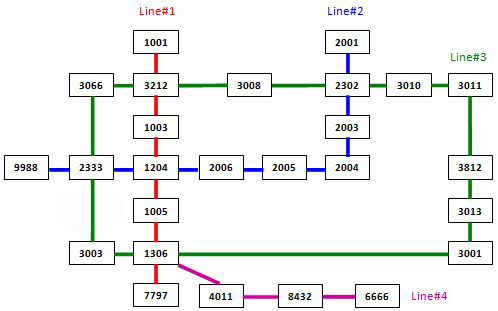题目描述
In the big cities, the subway systems always look so complex to the visitors. To give you some sense, the following figure shows the map of Beijing subway. Now you are supposed to help people with your computer skills! Given the starting position of your user, your task is to find the quickest way to his/her destination.

Input Specification:
Each input file contains one test case. For each case, the first line contains a positive integer NNN (≤\le≤ 100), the number of subway lines. Then NNN lines follow, with the iii-th (i=1,⋯,Ni=1, \cdots , Ni=1,⋯,N) line describes the iii-th subway line in the format:
MMM S[1] S[2] ... S[MMM]
where MMM (≤\le≤ 100) is the number of stops, and S[iii]'s (i=1,⋯,Mi=1, \cdots , Mi=1,⋯,M) are the indices of the stations (the indices are 4-digit numbers from 0000 to 9999) along the line. It is guaranteed that the stations are given in the correct order -- that is, the train travels between S[iii] and S[i+1i+1i+1] (i=1,⋯,M−1i=1, \cdots , M-1i=1,⋯,M−1) without any stop.
Note: It is possible to have loops, but not self-loop (no train starts from S and stops at S without passing through another station). Each station interval belongs to a unique subway line. Although the lines may cross each other at some stations (so called "transfer stations"), no station can be the conjunction of more than 5 lines.
After the description of the subway, another positive integer KKK (≤\le≤ 10) is given. Then KKK lines follow, each gives a query from your user: the two indices as the starting station and the destination, respectively.
The following figure shows the sample map.

Note: It is guaranteed that all the stations are reachable, and all the queries consist of legal station numbers.
Output Specification:
For each query, first print in a line the minimum number of stops. Then you are supposed to show the optimal path in a friendly format as the following:
Take Line#X1 from S1 to S2.
Take Line#X2 from S2 to S3.
where Xiii’s are the line numbers and Siii’s are the station indices. Note: Besides the starting and ending stations, only the transfer stations shall be printed.
If the quickest path is not unique, output the one with the minimum number of transfers, which is guaranteed to be unique.
Sample Input:
4 7 1001 3212 1003 1204 1005 1306 7797 9 9988 2333 1204 2006 2005 2004 2003 2302 2001 13 3011 3812 3013 3001 1306 3003 2333 3066 3212 3008 2302 3010 3011 4 6666 8432 4011 1306 3 3011 3013 6666 2001 2004 3001
Sample Output:
2 Take Line#3 from 3011 to 3013. 10 Take Line#4 from 6666 to 1306. Take Line#3 from 1306 to 2302. Take Line#2 from 2302 to 2001. 6 Take Line#2 from 2004 to 1204. Take Line#1 from 1204 to 1306. Take Line#3 from 1306 to 3001.
解析
通过这道题让我学到了很多东西,知道原来DFS、BFS算法也是可以求解最短路径问题的,但只是对于顶点之间没有距离可言的时候DFS、BFS才会比较容易。
一开始是想用BFS算法求解这道题,后来发现,由于题目要求维护换乘数这个量,那么这时候BFS好像并不是很方便。反而DFS更容易维护,只是需要求出所有能到达终点的路径,再从中选择最优路径。(有种Dijkstra+DFS的感觉)。
BFS错误代码
#include<iostream>
#include<cstring>
#include<string>
#include<vector>
#include<map>
#include<set>
#include<unordered_map>
#include<unordered_set>
#include<stack>
#include<queue>
#include<cmath>
#include<algorithm>
using namespace std;
const int maxn = 10000;
int pre[maxn];
bool inq[maxn];
vector<int> adj[maxn];
unordered_map<int, int> line;
void bfs(int s, int des) {
queue<int> q;
q.push(s);
inq[s] = 1;
while (!q.empty()) {
int now = q.front(); q.pop();
if (now == des) return;
for (int i = 0; i < adj[now].size(); i++) {
if (inq[adj[now][i]] == 0) {
q.push(adj[now][i]);
pre[adj[now][i]] = now;
inq[adj[now][i]] = 1;
}
}
}
}
int main() {
#ifdef ONLINE_JUDGE
#else
freopen("1.txt", "r", stdin);
#endif
int n; cin >> n;
for(int i=1;i<=n;i++) {
int m, pre=0, temp; cin >> m;
for (int j = 0; j < m; j++) {
scanf("%d", &temp);
line[pre * 10000 + temp] = line[temp * 10000 + pre] = i;
if (j != 0) {
adj[pre].push_back(temp);
adj[temp].push_back(pre);
}
pre = temp;
}
}
int k, s, des; cin >> k;
while (k--) {
scanf("%d%d", &s, &des);
memset(pre, 0, sizeof(pre));
memset(inq, 0, sizeof(inq));
bfs(s, des);
vector<int> path;
int u=des;
while (1) {
path.push_back(u);
if (u == s) break;
u = pre[u];
}
int len = path.size();
printf("%d\n", len-1);
int nowline = line[path[len - 1] * 10000 + path[len - 2]];
for (int i = path.size() - 3; i >= 0; i--) {
int templine = line[path[i + 1] * 10000 + path[i]];
if (templine != nowline) {
printf("Take Line#%d from %04d to %04d.\n", nowline, s, path[i+1]);
s = path[i+1];
nowline = templine;
}
}
printf("Take Line#%d from %04d to %04d.\n", nowline, s, des);
}
return 0;
}
DFS AC代码
#include<iostream>
#include<cstring>
#include<string>
#include<vector>
#include<map>
#include<set>
#include<unordered_map>
#include<unordered_set>
#include<stack>
#include<queue>
#include<cmath>
#include<algorithm>
using namespace std;
const int maxn = 10000;
bool vis[maxn];
vector<int> adj[maxn], temppath, path;
int line[maxn][maxn], minStation, minLineNum; //line相当于邻接矩阵
//minStation、minLineNum分别是最小站点数,最小换乘数
int lineNum(vector<int> path) {
int preLine=0, cnt=0;
for (int i = 1; i < path.size(); i++) {
if (line[path[i - 1]][path[i]] != preLine) cnt++;
preLine = line[path[i - 1]][path[i]];
}
return cnt;
}
void dfs(int u, int &des, int cnt) {
vis[u] = 1; temppath.push_back(u);
if (u == des && (cnt < minStation || cnt == minStation && lineNum(temppath) < minLineNum)) {
path = temppath;
minStation = cnt;
minLineNum = lineNum(temppath);
return;
}
for (int i = 0; i < adj[u].size(); i++) {
int v = adj[u][i];
if (vis[v] == 0) {
dfs(v, des, cnt+1);
vis[v] = 0; //由于已访问过的也可能构成最优路径,需要恢复vis[v]为0
temppath.pop_back();
}
}
}
int main() {
#ifdef ONLINE_JUDGE
#else
freopen("1.txt", "r", stdin);
#endif
int n; cin >> n;
for(int i=1;i<=n;i++) {
int m, pre=0, temp; cin >> m;
for (int j = 0; j < m; j++) {
scanf("%d", &temp);
if (j != 0) {
line[pre][temp] = line[temp][pre] = i;
adj[pre].push_back(temp);
adj[temp].push_back(pre);
}
pre = temp;
}
}
int k, s, des; cin >> k;
while (k--) {
scanf("%d%d", &s, &des);
memset(vis, 0, sizeof(vis));
minStation = maxn; minLineNum = maxn;
temppath.clear();
dfs(s, des, 0);
printf("%d\n", minStation);
int preLine = 0, nowLine=0;
for (int i = 1; i < path.size(); i++) {
nowLine = line[path[i - 1]][path[i]];
if (nowLine != preLine) {
if(i!=1) printf("Take Line#%d from %04d to %04d.\n", preLine, s, path[i - 1]);
s = path[i - 1];
preLine = nowLine;
}
}
printf("Take Line#%d from %04d to %04d.\n", nowLine, s, des);
}
return 0;
}
